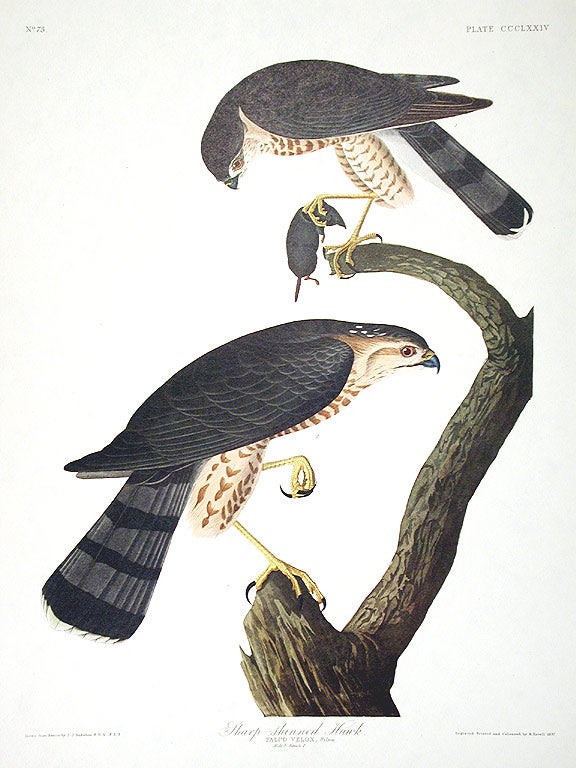Wednesday. Concord. P. M.—To Walden, with E. Bartlett and E. Emerson.
The former wished to show me what he thought an owl’s nest he had found. Near it, in Abel Brooks’s wood lot, heard a note and saw a small hawk fly over. It was the nest of this bird. Saw several of the young flitting about and occasionally an old bird.
The nest was in a middling-sized white pine, some twenty feet from the ground, resting on two limbs close to the main stem, on the south side of it. It was quite solid, composed entirely of twigs about as big round as a pipe-stem and less; was some fifteen inches in diameter and one inch deep, or nearly flat, and perhaps five inches thick. It was very much dirtied on the sides by the droppings of the young.
As we were standing about the tree, we heard again the note of a young one approaching. We dropped upon the ground, and it alighted on the edge of the nest; another alighted near by, and a third a little further off. The young were apparently as big as the old, but still lingered about the nest and returned to it.
I could hear them coming some distance off. Their note was a kind of peeping squeal, which you might at first suspect to be made by a jay; not very loud, but as if to attract the old and reveal their whereabouts.
The note of the old bird, which occasionally dashed past, was somewhat like that of the marsh hawk or pigeon woodpecker, a cackling or clattering sound, chiding us. The old bird was anxious about her inexperienced young, and was trying to get them off. At length she dashed close past us, and appeared to fairly strike one of the young, knocking him off his perch, and he soon followed her off.
I saw the remains of several birds lying about in that neighborhood, and saw and heard again the young and old there abouts for several days thereafter.
A young man killed one of the young hawks, and I saw it. It was the Falco fuscus, the American brown or slate-colored hawk.
 |
| J. J. Audubon Sharp-shinned Hawk |
Its length was thirteen inches; alar extent, twenty-three. The tail reached two or more inches beyond the closed wings. Nuttall says the upper parts are “a deep slate color” (these were very dark brown); also that the nest is yet unknown. But Wilson describes his F. velox (which is the same as Nuttall’s F. fuscus) as “whole upper parts very dark brown,” but legs, greenish-yellow (these were yellow). The toes had the peculiar pendulous lobes which W. refers to.
As I saw it in the woods, I was struck by its dark color above, its tawny throat and breast, brown-spotted, its clean, slender, long yellow legs, feathered but little below the knee, its white vent, its wings distinctly and rather finely dark-barred beneath, short, black, much curved bill, and slender black sharp claws. Its tail with a dark bar near edge beneath.
In hand I found it had the white spots on scapulars of the F. fuscus, and had not the white bars on tail of the F. Pennsylvanicus. It also had the fine sharp shin.
But what then is my hawk killed by Farrar, with so stout a leg? Had that any white bars on tail?
H. D. Thoreau, Journal, July 21, 1858
In Abel Brooks’s wood lot, heard a note and saw a small hawk fly over. It was the Falco fuscus, the American brown or slate-colored hawk. See May 4, 1855 (“Sitting in Abel Brooks’s Hollow, see a small hawk go over high in the air, with a long tail and distinct from wings. It advanced by a sort of limping flight yet rapidly, not circling nor tacking, but flapping briskly at intervals and then gliding straight ahead with rapidity, controlling itself with its tail. It seemed to be going a journey. Was it not the sharp-shinned, or Falco fuscus? I think that what I have called the sparrow hawk falsely, and latterly pigeon hawk, is also the sharp-shinned (vide April 26th and May 8th, 1854, and April 16th, 1855), for the pigeon hawk’s tail is white-barred.”); September 22, 1852 ("Some of those I see are probably the sharp-shinned hawk."); March 28, 1854 (“See a small slate-colored hawk, with wings transversely mottled beneath, — probably the sharp-shinned hawk.”); April 26, 1854 (“Saw probably a pigeon hawk skim straight and low over field and wood, and another the next day apparently dark slate-color.”); May 8, 1854 (“Saw a small hawk flying low, about size of a robin — tail with black bars”); April 16, 1855 ( "What I call a pigeon hawk, probably sharp-shinned.”); ; April 25, 1860 ("Looking up, I see what I take to be a sharp-shinned hawk just alighting on the trees . . . The hawk plumes himself, and then flies off, rising gradually and beginning to circle, and soon it joins its mate, and soars with it high in the sky and out of sight. . . It appeared to have a plain reddish-fawn breast. The size more than anything made me think it a sharp-shin."). See also A Book of the Seasons, by Henry Thoreau, the sharp-shinned hawk. and A Book of the Seasons by Henry Thoreau, The Pigeon Hawk (Merlin)
But what then is my hawk killed by Farrar, with so stout a leg? See October 11, 1856 (“Farrar gave me a wing and foot of a hawk which he shot about three weeks ago . . . . This foot has a sharp shin and stout claws, but the wing is much larger than that of the Falco fuscus (or sharp-shinned hawk), being, . . . the size of the F. Pennsylvanicus. ”)





No comments:
Post a Comment